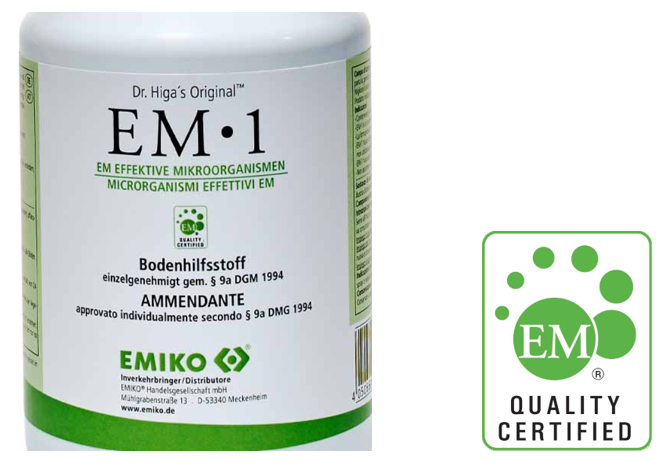Semblance of a certification mark – EM QUALITY CERTIFIED
The case: Healthy soil and clean water are an important basis for environmentally friendly and healthy products. To create these conditions, the Japanese EM Research Organisation (EMRO) activates microorganisms already present in soil and water using methods it invented itself, maximising the natural power and effect of the organisms. In 1997, the company registered the following trade mark in the European Union Register for a variety of products.

‘EM’ stands for ‘effective microorganisms’. The trade mark is only intended for those products that have been produced on the basis of this environmentally friendly technology.
EMRO was not amused, however, when the German company ‘em chiemgau’ launched an application for
EM blond
as a German word mark, for, among other things, fertilisers and cleaning agents as well as for cultures of microorganisms. EMRO filed an opposition against the application, claiming a likelihood of confusion with its trade mark.
‘em chiemgau’ rejected this claim and contested the genuine use of the ‘EM mark’ in the European Union. They argued, first, that EMRO had been using a different sign and, second, that the ‘EM trade mark’ had lapsed and the opposition should be rejected for that reason alone.
In fact, EMRO had only used its trade mark on products as follows:

While the mark thus had the appearance of a so-called certification mark, this is not sufficient for it to qualify as use of an individual trade mark:
The certification mark is a completely different type of mark from the usual individual marks, and it has only existed in the European Union since 1 October 2017.
With a certification mark, an independent certification company certifies the quality of third-party products. The guarantee function of the trade mark is in the foreground. This is because it distinguishes products of a certain quality, guaranteed by the trade mark owner, from other products for which such a guarantee does not exist. The guarantee mark only indirectly refers to the certification company that offers the guarantee in question. In order to maintain its own trade mark, the certification company must have a completely neutral position.
In contrast, individual trade marks, which have existed since time immemorial, serve to indicate the origin of goods and services as being from a specific company. The trade mark owner uses the individual trade mark (which belongs to the owner) in the course of trade as a means of distinguishing those products. Inevitably, the owner of an individual trade mark has no duty towards maintaining neutrality. Any indication of the quality of their goods is merely a secondary function of their trade mark. And the trade mark ultimately loses its protection if it is not used to create or maintain market share for its owner.
Thus, the use of an individual trade mark as a certification mark cannot constitute genuine use of the individual trade mark. If an individual trade mark only highlights quality features, it is not used in accordance with its essential function, which is to guarantee the identity of the origin of the goods or services for which it is registered, in order to create or preserve an outlet for those goods or services.
It was clear that the use of the figurative mark ‘EM’ created the impression of a certification mark: the certification notice ‘QUALITY CERTIFIED’ had the same black colour as the ‘R in a circle’ standing for ‘registered’. The certification notice, together with the ‘R’, therefore referred to the figurative mark ‘EM’ in green, and indicated a registered certification mark. On the packaging, the sign also appeared only as a secondary marking next to the actual product mark (such as in the example: EMIKO).
Because the figurative mark ‘EM’ was thus only used in the form of a certification mark, it could be cancelled. The company’s opposition was consequently rejected.
Federal Patent Court (BPatG) of 03 February 2022, 30 W (pat) 511/20.
Learnings: Do not try to give your individual brand the appearance of a certification brand. Not only could you render your valuable brand unprotected, but you also risk destroying it. For quality guarantees, in particular, you should instead seek to obtain a licence to use a certification mark.
Also see: